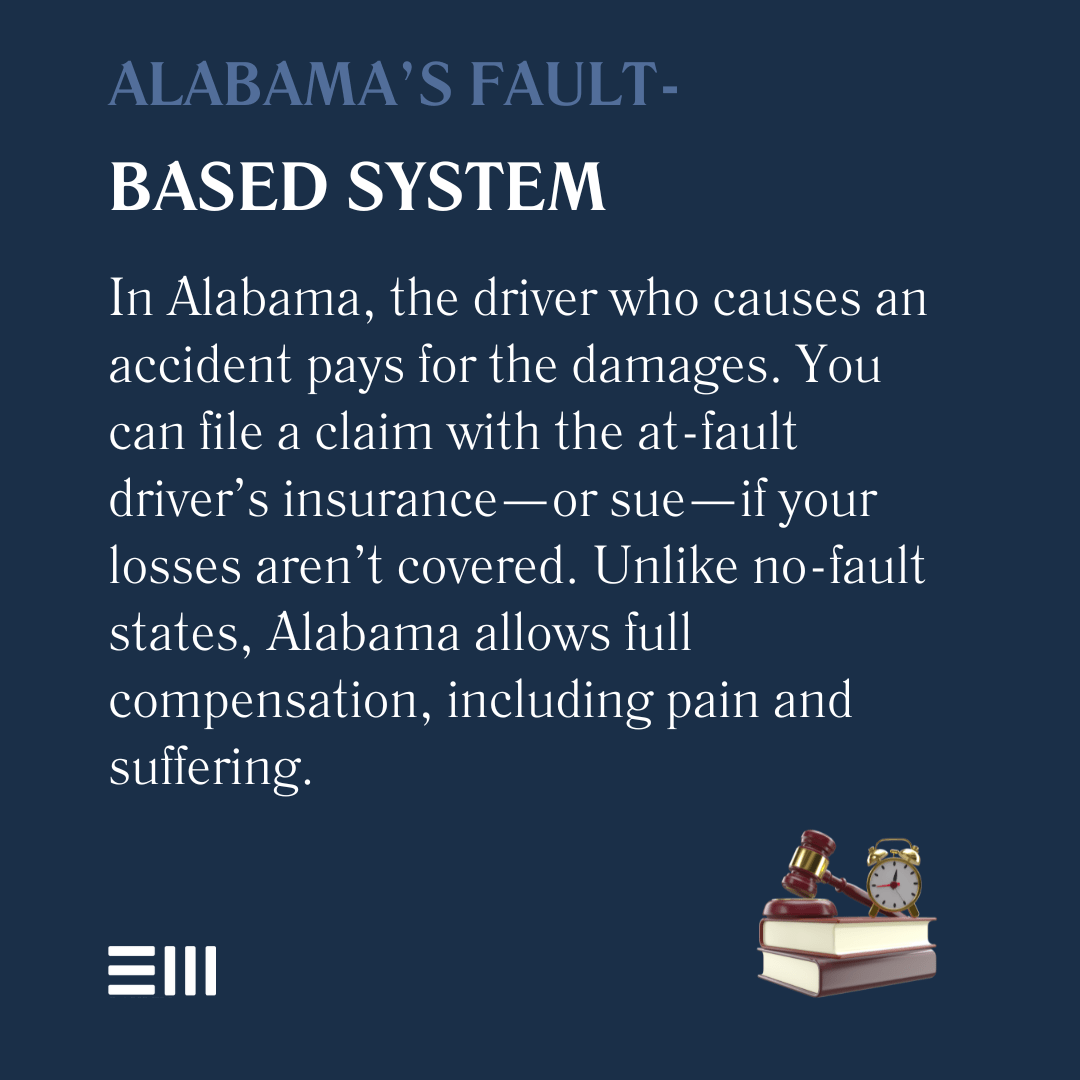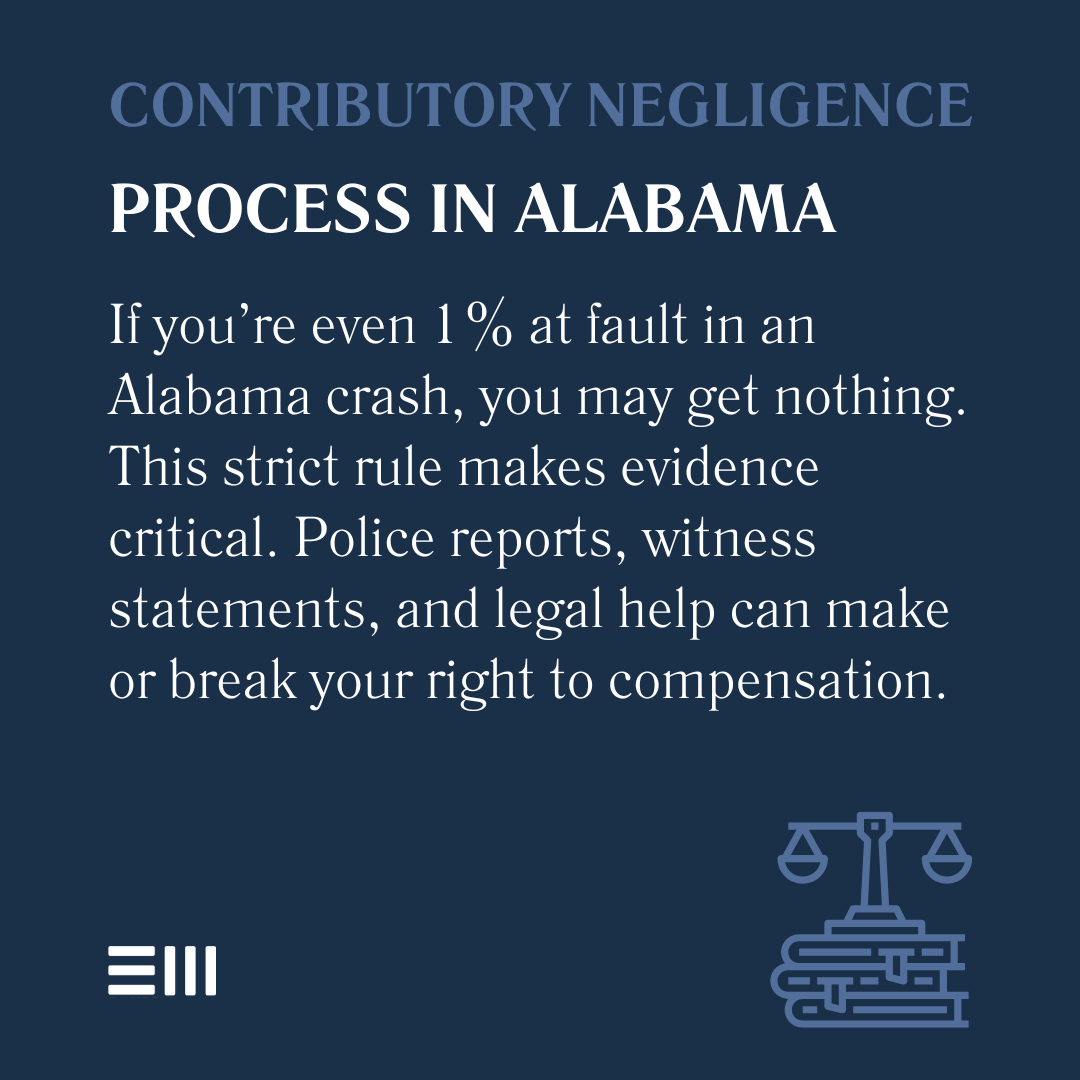Only twelve states in America operate under no-fault insurance systems, leaving drivers in the remaining states to navigate traditional fault-based insurance laws that can significantly complicate accident claims and recovery processes.
Alabama operates under a traditional fault-based system, meaning the driver who causes an accident bears financial responsibility for resulting damages and injuries.
Understanding Alabama's fault-based insurance system becomes particularly important when you're involved in an accident, as it affects everything from which insurance company pays your medical bills to your ability to pursue compensation for pain and suffering.
The state's approach to fault determination can dramatically impact your recovery options and the amount of compensation available after a car accident.
Alabama's Fault-Based Insurance System
Alabama follows a traditional fault-based insurance system where the driver responsible for causing an accident must pay for damages and injuries resulting from the collision. This system contrasts sharply with no-fault states, where each driver's insurance covers their own losses regardless of who caused the accident.
Under Alabama's fault-based system, accident victims can pursue compensation directly from the at-fault driver's insurance company for medical expenses, lost wages, property damage, and pain and suffering. This approach allows for more comprehensive recovery than no-fault systems, which typically limit compensation to economic losses only.
The fault-based system requires a thorough investigation of accident circumstances to determine which driver bears responsibility. Alabama's system also allows injured parties to file personal injury lawsuits against at-fault drivers when insurance coverage proves inadequate.
This traditional approach gives Alabama drivers more options for recovery, but also places greater importance on proper evidence gathering and legal representation following accidents.
How Fault Determination Works in Alabama
Alabama uses several methods to determine fault in auto accidents, with the process often involving multiple parties, including police officers, insurance adjusters, and sometimes legal professionals. Understanding this process helps drivers know what to expect after an accident occurs.
Police reports serve as the initial official documentation of accident circumstances, with responding officers noting their observations about vehicle positions, damage patterns, and any traffic violations that may have contributed to the crash.
Insurance company investigations involve adjusters examining physical evidence and interviewing drivers and witnesses.
Alabama follows a pure contributory negligence rule, which means that if you contributed even minimally to causing your own accident, you may be barred from recovering any compensation from other drivers.
This harsh rule makes fault determination particularly important in Alabama.
The complexity of fault determination in Alabama emphasizes the importance of gathering thorough evidence and potentially seeking legal assistance when serious accidents occur.
Differences Between No-Fault and Fault-Based States
The distinction between no-fault and fault-based insurance systems creates dramatically different experiences for accident victims, affecting everything from initial medical care to long-term compensation opportunities.
Understanding these differences helps Alabama drivers appreciate their state's approach.
- Compensation Sources - Fault-based states allow claims against at-fault drivers' insurance, while no-fault states require using your own coverage first.
- Pain and Suffering Damages - Alabama drivers can pursue non-economic damages, while many no-fault states restrict such compensation.
- Lawsuit Rights - Fault-based systems preserve the right to sue for damages, while no-fault states typically limit litigation to severe injury cases.
- Insurance Requirements - No-fault states mandate personal injury protection coverage, while Alabama requires liability coverage for damages you cause.
- Claim Processing Speed - No-fault systems often provide faster initial payments, while fault-based systems may involve longer investigations.
These fundamental differences make Alabama's system more favorable for comprehensive compensation but potentially slower for immediate expense coverage.
Alabama's Insurance Requirements
Alabama law mandates specific minimum insurance coverage levels that reflect the state's fault-based system, requiring drivers to carry liability coverage that protects other parties when they cause accidents. Understanding these requirements helps ensure legal compliance and adequate protection.
Bodily injury liability coverage must provide at least $25,000 per person and $50,000 per accident for injuries caused to others. Property damage liability requires minimum coverage of $25,000 per accident for damage to other vehicles and property.
Alabama does not require personal injury protection (PIP) coverage, which is mandatory in no-fault states. However, drivers may purchase optional uninsured motorist coverage, which becomes particularly valuable when at-fault drivers lack adequate insurance.
The state's minimum coverage requirements represent basic legal compliance but may prove inadequate for serious accidents, making higher coverage limits a wise investment for comprehensive protection.
Advantages and Disadvantages of Alabama's System
Alabama's fault-based insurance system creates both benefits and challenges for drivers involved in accidents, with the overall impact depending on specific accident circumstances and individual situations. Evaluating these factors helps drivers understand what to expect.
Advantages include the ability to recover full compensation for all damages, including pain and suffering, the right to pursue claims against at-fault drivers for complete recovery, and no restrictions on lawsuit rights regardless of injury severity. The system allows accident victims to seek compensation beyond their own policy limits.
Disadvantages involve potentially longer claim resolution times due to fault investigations, the risk of receiving no compensation under contributory negligence rules if you're partially at fault, and complications when fault disputes aris,e requiring legal intervention.
Despite these challenges, Alabama's system generally provides more comprehensive compensation opportunities for accident victims compared to restrictive no-fault alternatives.
Frequently Asked Questions
Alabama's fault-based insurance system generates numerous questions from drivers trying to understand their rights and obligations following accidents.
These common concerns address the most frequent issues that arise under the state's insurance laws.
What Should I Do Immediately After an Accident in Alabama?
Ensure everyone's safety first, then call police to report the accident and seek medical attention for any injuries. Document the scene with photos, gather witness information, and exchange insurance details with other drivers while avoiding discussions of fault or admissions of responsibility.
Can I Still Recover Compensation if I Was Partially at Fault?
Alabama's contributory negligence rule can bar recovery if you contributed to causing your accident, even minimally. However, fault determination involves complex legal analysis, and what initially appears to be partial fault may not hold up under thorough investigation.
How Long Do I Have to File a Claim in Alabama?
Insurance claims should be filed promptly after accidents, while personal injury lawsuits must generally be filed within two years of the accident date. However, specific circumstances can affect these timelines, making prompt action advisable.
What if the at-Fault Driver Has No Insurance?
Your uninsured motorist coverage can provide compensation when at-fault drivers lack insurance. You may also pursue personal assets of uninsured drivers through legal action, though recovery depends on their financial resources.
Should I Accept the First Settlement Offer?
Initial settlement offers often undervalue claims, particularly for injuries that may worsen over time. Consider consulting with an attorney before accepting any settlement to ensure fair compensation for all current and future damages.
How Does Alabama's System Compare to No-Fault States?
Alabama's fault-based system allows more comprehensive compensation including pain and suffering damages and preserves full lawsuit rights, while no-fault states typically provide faster initial payments but limit overall recovery options.
These questions represent starting points for understanding Alabama's insurance system, but specific accidents involve unique circumstances requiring individual analysis and potentially professional legal guidance.
Navigate Alabama's Insurance System with Confidence
Understanding Alabama's fault-based insurance system is just the beginning—successfully navigating accident claims and ensuring fair compensation requires experienced legal guidance that knows how to build compelling cases and negotiate effectively with insurance companies.
The skilled personal injury attorneys at Baxley Maniscalco understand Alabama's contributory negligence laws, know how to investigate accidents thoroughly, and fight aggressively to establish fault while protecting our clients from unfair blame.
We've successfully handled countless cases under Alabama's challenging legal framework.
Don't let insurance companies take advantage of Alabama's harsh contributory negligence rule or accept inadequate settlements that fail to cover your full damages.
Our attorneys know how to gather evidence, work with experts, and present compelling arguments that maximize your compensation under Alabama law.
Contact our experienced Alabama accident attorneys today for a free consultation about your case.


